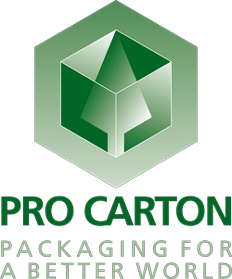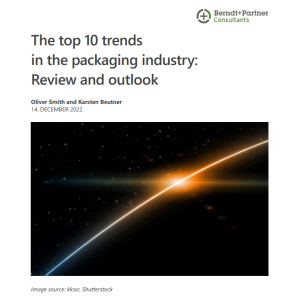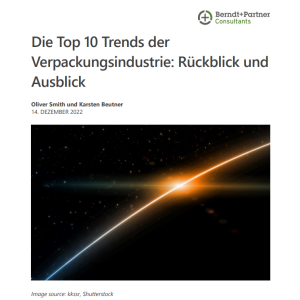14th December 2022
We came across an interesting article from Berndt+Partner Consultants on LinkedIn and are publishing it with their permission. We have included the English version in full (below) and also include links to the German and English PDF versions at the end of the article.
“In our first newsletter of 2022, we presented the top 10 trends in the packaging industry. They were the result of a B+P study in which we had examined the most important and consequential market developments and trends in more detail. As the new year approaches, we want to put these trends to the test – and see what awaits us in 2023.
At the beginning of 2022, we predicted that the packaging industry was facing profound and far-reaching upheavals. Under the heading “Stability was yesterday”, we had spoken in February, on the basis of our own study on the Top 10 Trends of the Packaging Industry, of a market that is becoming increasingly complex, confusing and at the same time dynamic.
Russia’s invasion of Ukraine with all its consequences has further reinforced this trend. New, mostly unexpected changes and drastic market upheavals were the result.
Our assessment that the future viability of many business models is in question and that decision-making certainty has become a meager commodity has unfortunately been confirmed – and doubly underscored by events.
In addition to the new events with disruptive consequences, there continue to be changes that have been known for many years – but have been slept through by much of the packaging industry.
But there is also good news: the effects here and there are serious, but controllable. The packaging industry is facing disruptive changes that bring many risks but also offer great opportunities.
It is crucial to know and internalize the most far-reaching and dynamic trends. Because only deep and broad market knowledge leads to safe and successful decisions. With the “Top 10 Trends revisited” we want to lay an initial foundation for this. We will be happy to be at your side in the new year as well.
Top 10 trends revisited
You will find our assessment from the beginning of the year at the start of the trends.
In the following, we evaluate and look ahead.
Trend #1: Consumers expect more sustainability (Confirmed with additions)
A new generation is changing buying behavior and consumer attitudes toward sustainability. This will result in huge changes for packaging.
Eighty-three percent of consumers are willing to pay more for an item with sustainable packaging. In 2010, that number was just under 16 percent.
Comment and outlook: The trend is confirmed and will continue to grow. However, in view of dwindling purchasing power due to the increased cost of living and strong inflation, there are one or two potential brakes. This will not change the medium- and long-term importance of the sustainability issue. It does, however, open up opportunities when others take a back seat in the short term.
Trend #2: Corona changes purchasing behavior (Expired. New trend: Inflation & Co.)
The global health crisis has accelerated processes such as digitalization and the development of e-commerce. The packaging industry must keep pace with these developments.
Comment and outlook: This trend has run its course and is hardly relevant for 2023. Of course, the changes around digitalization remain of paramount importance (see Trend #9). However, the pandemic crisis will be replaced by the Ukraine crisis. Energy crisis, intensified inflation and recession are the dominant new themes.
Inflation
Inflation has a major impact on purchasing behavior
The British market research company Global Data, for example, is observing a polarization of consumer buying behavior. According to this, consumers are either
- Spend less by buying less overall,
- save money by switching to cheaper products, or
- buy higher-quality products to achieve better value for money.
Polarization of the market
These divergent consumer responses are leading to polarization in the market, according to Global Data’s analysis. Brands are either increasing pack sizes to appeal to bulk buyers or reducing pack sizes.
The key, according to Global Data, will be value for money. Solutions such as larger pack sizes and reusable packaging are expected to become more prevalent.
Private label products
As a result of lower disposable income and tighter budgets overall, Global Data predicts that demand for private label products will increase. For example, according to the study, nearly one-third of consumers worldwide already say they typically purchase private label dairy products.
Packaging design and cost
If high-priced products are in danger of disappearing from shelves as consumers switch to private label and cheaper alternatives, there are clear implications for packaging design and cost.
Package sizes
There is also a forecast from Global Data on pack sizes: it states that packaging with a volume of 3,001 to 5,000 g/ml will grow at a rate of 4.3 percent annually through 2025, faster than smaller pack sizes. Notwithstanding this, the analyses predict that smaller pack sizes will continue to dominate the consumer packaging market overall.
In the longer term, a simultaneous increase in small and large pack sizes is assumed. This polarization will then be at the expense of standard mid-size packs.
Trend #3: Fluctuating & Rising Raw Material Prices (Confirmed and Strengthened).
Packaging often has a raw material content of 50-70%. Due to the high volatility of raw material prices, there is no continuity and planning security for the companies. The resulting risk is very high.
Comment and outlook: The situation has deteriorated significantly this year due to high inflation combined with rising energy costs. In terms of energy costs, the outlook shows a level that is worrying for production.
Plastics – Status September 2022
A recent survey by the IK Industrievereinigung Kunststoffverpackungen e.V. among its 300 member companies shows,
- that high energy costs have reached levels that threaten the existence of one in five companies in the industry. Similar to many other energy-intensive industries, the mostly medium-sized manufacturers of plastic packaging and films in Germany are shocked by the dramatic increases in electricity and gas prices.
- Electricity: So far, some companies have been able to avoid cost increases due to ongoing contracts. However, on average across the industry, electricity costs have doubled since the beginning of the year. Some companies are even facing electricity prices that are 300, 500 or up to 750 percent higher than at the beginning of the year.
- Natural gas: The current situation is similar here. Prices are up to 625 percent higher than in January. The price of natural gas has also doubled on average for the industry.
Paper – as of December 2022
54.3% of German paper mills believe short-time working is possible in the foreseeable future. This is the result of a member survey conducted by the industry association Die Papierindustrie. The reason: many companies can no longer pass on the skyrocketing energy costs to their customers. In case of doubt, the only thing left for them to do is to cut back production, according to the association. It puts the drop in production since May 2022 at 12.5 percent.
General Outllook – 2023
In the coming year, the situation will continue to worsen.
- In 2023, electricity is expected to see increases of up to 1,200 percent in individual cases, with an average increase of about 240 percent.
- Most companies also expect at least a doubling of natural gas prices. Again, the highest estimates are for increases in excess of 1,000 percent in individual cases. On average, natural gas prices are currently forecast to increase 250 percent in 2023.
Trend #4: Changing Investor Expectations (Confirmed – Growing Momentum)
Over 90% of investors rank verifiable sustainability activities as important to their investment and investment decisions.
Companies that do not operate sustainably will have a hard time getting investors’ money in the future. Investors expect measurable and verifiable progress. This applies to all industries, but especially to the packaging industry!
Comment and outlook: This trend remains relevant and will continue to grow in intensity.
Trend #5: New government regulations in the areas of environment, health and safety (Confirmed).
Based on the EU CSR reporting directive, the first companies will be required to report on sustainability from 2024. In the first stage, this applies to companies with 250 or more employees or at least €40 million in sales.
Many companies are not sufficiently prepared and need to invest more money in their legal teams to keep up with the new developments.
Comment and outlook: Legislation continues unabated with regard to sustainability. Not only in terms of circular economy, but also in terms of climate neutrality. Legislation is vehemently pushing for a climate-neutral circular economy.
Trend #6: Brand and consumer protection (Confirmed – intensification)
The counterfeiting industry is becoming increasingly professional. More counterfeit-proof packaging needs to be developed and deployed to protect business and consumers.
Comment and Outlook: This trend remains relevant and will increase in intensity.
Trend #7: Growth in emerging markets. (Confirmed – Changes).
As markets in South America, Africa and especially Asia approach the per capita consumption of packaging in developed countries, packaging demand in these regions will explode.
Comment and Outlook: This trend will continue to be topical. Here, too, the intensity will increase. At the same time, there are opposing trends that act as brakes. These include deglobalization in the sense of reduced dependencies and demarcations, for example, vis-à-vis Russia and China.
Current data show particularly large volume growth in primary FMCG packaging in India, the Philippines, Indonesia, Peru and Egypt in the coming years.
Trend #8: Circular Economy (Confirmed – Intensification)
As the most influential NGO in the packaging world, the Ellen MacArthur Foundation sets a clear framework with its New Plastics Economy: A complete shift to recycled or compostable plastics or reusable systems by 2025 and elimination of “problem” materials (e.g., PVC, EPS, PS). More than 500 companies are joining in and committing, including big players such as Nestlé and Unilever.
Many brand owners and retailers are increasingly focusing on circular economy in their packaging strategies. The packaging industry is at the center of the circular economy and therefore facing radical changes.
Comment and outlook: This trend remains topical and with increasing intensity. Climate is becoming the most dominant sustainability issue. Brand owners are increasingly focusing on the issue of climate neutrality and are trying to reduce their packaging carbon footprint accordingly. CO2 is becoming its own currency in relation to products.
Trend #9: Digitalization (Confirmed – Intensification)
The Corona crisis is decisively accelerating the pace of digitalization in Germany. The packaging industry is still lagging behind and needs to catch up further compared to other sectors.
80 percent of packaging executives believe in digitization as a growth driver for productivity, sales and innovation. Only 40 percent have invested in AI technology.
Comment and outlook: This trend remains relevant and the intensity will increase. Digitization is the key to winning new customers and an essential component of business model renewal. We are therefore happy to recommend our article on this topic in the B+P Newsletter 01/2022 again.
Trend #10: Market consolidation (Confirmed – Intensification)
More than 100 packaging companies with a consolidated turnover of more than €10 billion are sold and integrated annually in Europe.
Market consolidation continues to progress in all packaging segments and technology areas. Smaller companies that cannot find a niche are being bought out.
Comment and outlook: This trend continues to be topical. Its intensity will increase. Differentiation will become the key to growth, especially via services.”





